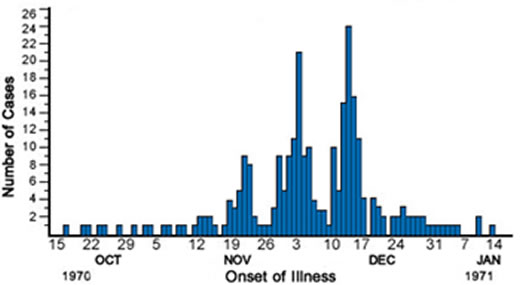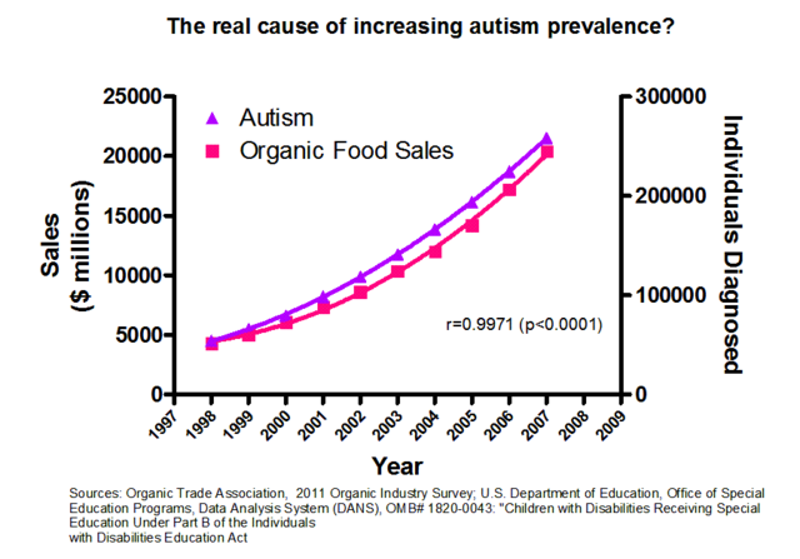What if Vaccines Are Harmful?

I’m in the process of reviewing an article on the “gut microbiome” and it’s alleged connection to Autism Spectrum Disorder (ASD). The more I review it, the more I keep reading little hints and dog whistles harking back to Andrew Wakefield’s fraudulent study. More on that once I get done with reading and analyzing what they did…
Anyway, I got to thinking about the whole “debate” about vaccines lately, and I was thinking: If vaccines really are harmful, what exactly would we be seeing? Let me start with a story or two, and then maybe you’ll see what I mean.
Kaposi’s Sarcoma and HIV/AIDS
Back in the late 1970s and early 1980s, physicians treating gay men noticed that some of them were presenting with Kaposi’s sarcoma, a rare kind of cancer of the skin. Kaposi’s is caused by a herpes virus that is usually kept in check by a healthy immune system. If something happens to the immune system, the virus multiplies like crazy on the skin and causes the lesions typical of the disease.
At that time, the disease was rare, and it was only seen in a few people who had a condition that would affect their immune system. All of a sudden, relatively healthy, young men were coming down with it. These physicians shared their observations through case studies and with colleagues. Soon thereafter, the public health authorities caught on that something was going on mostly in gay men, and then soon thereafter in the general population. As we know now, what was going was the emergence of HIV as a cause of AIDS, and AIDS as a condition causing a compromised immune system incapable of keeping the virus at bay and triggering the cancer.
Tampons and Toxic Shock Syndrome
Also in the 1980s, young women started to be seen at emergency rooms and at physician offices with symptoms of what turned out to be toxic shock syndrome. Those physicians reported the cases to public health, and epidemiologists put the data together to figure out that something was happening to those women around the time that they were getting their period. A case-control study followed, and it was discovered that a specific brand of tampons was at fault.
See the Pattern?
In both of those instances, the first signs that something was going required contact with healthcare. Physicians made the diagnosis/observation of the disease and then reported it to their peers. Those reports were compiled and public health authorities launched an investigation. Studies were done, both observational (like a case-control study) and experimental, and conclusions were reached. Those conclusions met strict criteria for what is biologically plausible and statistically possible.
So what would it be like if vaccines caused harm?
It’s Not Just VAERS
You might have heard of the Vaccine Adverse Events Reporting System, or VAERS. It is a passive reporting system where anyone and everyone can go and report an adverse event from a vaccine. You can go look at the data right now if you want to. However, it’s not just VAERS that helps see the first “signals” of something being wrong with a vaccine.
There are other systems, like the Vaccine Safety Datalink Safetylink (VSD) and the systems that exist at the state and local level in some jurisdictions. Then there is the competition between pharmaceutical industries. If vaccine A causes harm, then the manufacturers of vaccine B will be all over it to sell vaccine B to the public and tell the public that vaccine A is harmful. And then there is the Food and Drug Administration working in conjunction with local, state and federal public health, academic researchers and private industry to keep an eye on all, uh, foods and drugs.
If something were to happen with vaccines, red flags would go up all over the place. And red flags have very much gone up.
Into… Hold On… Inter… Intussusception?
In the late 1990s, a vaccine against rotavirus (an intestinal virus that causes diarrhea) was put on the market. The phase 0, 1, 2 and 3 trials were done. The data checked out. The Advisory Committee on Immunizations Practices looked at the data and recommended the vaccine be put on the schedule. Babies all over the United States were given the vaccine.
Just like it happened with Kaposi’s and the toxic shock syndrome, babies with intussusception (where their intestine folds in on itself) were taken to emergency rooms and treated for the potentially life-threatening condition. Intussusception is itself a complication from rotavirus infection, and almost 2,000 children would get it each year in the United States.
However, as part of the medical investigation, astute healthcare providers noticed that the children had been recently vaccinated with a particular brand of the rotavirus vaccine. They shared that information among their peers, others reported the same thing, public health was brought in… You know the drill. At the end, the vaccine was pulled from the market.
What had happened was that intussusception was so common before the vaccine, that it was hard to distinguish between the intussusception caused by the vaccine and the intussusception caused by the disease in the population where the clinical trials were done. One group would get the vaccine and the other would get a placebo. The two groups were not large enough to detect the “signal” of the intussusception in the vaccine group. It just seemed like it was the background/expected rate of the disease. So it wasn’t until the vaccine was given to a much, much larger group that the signal was amplified.
But, again, the vaccine was pulled from the market because it became clear that something was wrong. A different manufacturer learned from that mistake and designed their clinical trials accordingly, so they could see the signal in the noise and detect any problems. That is the vaccine that we now use in the United States. And, guess what? Not only did the cases of rotavirus precipitously drop after the vaccine, but so did the cases of intussusception. Why? Because natural rotavirus infection causes intussusception at a much higher rate than the vaccine. No rotavirus, not intussusception.
Ah, but most cases of intussusception are now being caused by the vaccine, right? Just like most polio cases are being caused by the polio vaccine? Well, yeah, sure, but you have to look at the alternative. The alternative is a massive increase in both rotavirus infection (diarrhea, and lots of it) and intussusception from rotavirus infection. Uh, no thanks!
Back to the Original Thesis of This Blog Post, if There Was One
So we hear a lot of stories from people who are generally anti-vaccine telling us that vaccines cause this or that. They point at general prevalence numbers on autism or food allergies and they say, “See? These things used to be rare, and now we see them everywhere because there are so many vaccines!”

However, time after time, study after study, nothing is really found to be caused by vaccines at a population level except the decrease in the incidence (new cases) of diseases that used to kill children by the thousands in the pre-vaccine era. So I ask again: What would we be seeing?
We would see healthcare providers — lots of them — sharing case reports of children (since they’re the ones getting most vaccines) developing some otherwise rare condition in the hours or days after being vaccinated. Those reports would be compiled and reported to public health. Case control studies would be done. Competing pharmaceutical companies would jump in. Academic researchers would also start looking at things closely.
There would be, literally, hundreds of thousands of people looking into what was going on, and we would all know the results because you can’t really keep a secret between hundreds of thousands of people.
This is exactly what happened when the first accusations of autism being caused by vaccines came out in the 1990s. Andrew Wakefield’s fraudulent study was impressive because he was claiming something that was unheard of. Pediatricians the world over looked at each other and were like, “Uh, I’ve seen autistic children be autistic before they were vaccinated.” Others, like me (a humble medical technologist at the time) looked at the biologic plausibility of what that fraudulent study was proposing. It didn’t make any sense that, first, the measles virus from the vaccine would migrate from the injection site to the intestine without being torn to shreds by the immune system and without causing classic measles disease and, second, that anything happening in the gut would trigger the set of behavioral deviations-from-the-norm that we see in autism.
I mean, we’ve seen the commercials about “you’re not you when you’re hungry,” but to take it a million steps forward and say that something in the gut messes with your brain development?

But We Kept Looking, Goddammit!
Just this year, in 2019, twenty years after Wakefield’s fraudulent study, a study from Denmark came out looking, once again, at the possible link between vaccines and autism. Guess what? No link. Instead of investing that money into worthwhile things, like accommodations and services for autistic children and adults, we are still chasing the biologically questionable and statistically improbable link between vaccines and autism.
And I say statistically improbable because about 20% of the US population is between 0 and 14 years of age. That’s over 60 million children! With vaccination rates higher than 90% in the whole country, that’s over 54 million children who received a vaccine at one point in their lives. If autism was really caused by vaccines, we would be seeing millions upon millions of new autism cases. Instead, we see a prevalence estimate that is still around 3% of all children, something the experts have long claimed is the true prevalence of autism in the human population throughout time.
Yes, there have been autistic people throughout time.
Can We Move On?
It’s going to be hard to move on and move away from the vaccine “debate” as long as certain things are true. First, as long as we have celebrities claiming to know more than scientists, and people willing to follow the celebrities instead of the science, we are going to have anti-vaccine people debating the science. Second, as long as scientists continue to be careful and indecisive in their response to questions about vaccine safety, we are going to have distrustful parents. And, third, as long as we have a pharmaceutical industry that operates like a black box where drugs and vaccines come out without much explanation of the science that went into making them, we are going to have people not trusting “Big Pharma.”
Can we move on? Yes. Will we?

Thre is a mistake in the text regarding name of the surveillance system on vaccine safety in the US. Vaccine Safety Datalink (VSD) is correct (not Vaccine Data Safetylink, VDS).
LikeLike
Thanks.
LikeLike